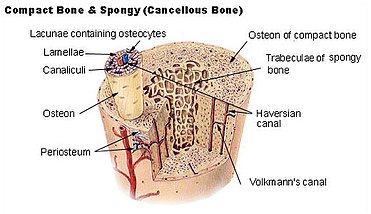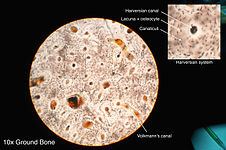This article has multiple issues. Please help improve it or discuss these issues on the talk page. (Learn how and when to remove these messages)
|
| Osteon | |
|---|---|
 Diagram of compact bone from a transverse section of a long bone's cortex. Diagram of compact bone from a transverse section of a long bone's cortex. | |
| Details | |
| Identifiers | |
| Latin | Osteon |
| MeSH | D006253 |
| Anatomical terminology[edit on Wikidata] | |


In osteology, the osteon or haversian system (/həˈvɜːr.ʒən/; named for Clopton Havers) is the fundamental functional unit of much compact bone. Osteons are roughly cylindrical structures that are typically between 0.25 mm and 0.35 mm in diameter. Their length is often hard to define, but estimates vary from several millimeters to around 1 centimeter. They are present in many bones of most mammals and some bird, reptile, and amphibian species.
Histogenesis
The Haversian system forms during the process of endochondral ossification, which starts with a cartilage template that is gradually replaced by bone tissue. Osteoblasts, the bone-forming cells, secrete the organic components of bone matrix and then initiates its mineralization. As osteoblasts become surrounded by the bone matrix, they differentiate into osteocytes, which reside in the lacunae and maintain bone tissue. The osteocytes connect to each other and the Haversian canal via tiny canals called canaliculi.
Structure

Each osteon consists of concentric layers, or lamellae, of compact bone tissue that surround a central canal, the Haversian canal. The Haversian canal contains the bone's blood supplies. The boundary of an osteon is the cement line.
Each Haversian canal is surrounded by varying number (5-20) of concentrically arranged lamellae of bone matrix. Near the surface of the compact bone, the lamellae are arranged parallel to the surface; these are called circumferential lamellae. Some of the osteoblasts develop into osteocytes, each living within its own small space, or lacuna. Osteocytes make contact with the cytoplasmic processes of their counterparts via a network of small transverse canals, or canaliculi. This network facilitates the exchange of nutrients and metabolic waste. Collagen fibers in a particular lamella run parallel to each other, but the orientation of collagen fibers within other lamellae is oblique. The collagen fiber density is lowest at the seams between lamellae, accounting for the distinctive microscopic appearance of a transverse section of osteons. The space between osteons is occupied by interstitial lamellae, which are the remnants of osteons that were partially resorbed during the process of bone remodeling.
Osteons are connected to each other and the periosteum by oblique channels called Volkmann's canals or perforating canals.
Drifting osteons
Drifting osteons are a phenomenon that is not fully understood. A "drifting osteon" is classified as one that runs both longitudinally as well as transversely through the cortex. An osteon can "drift" in one direction or change directions several times, leaving a tail of lamella behind the advancing haversian canal.
Investigative applications
In bioarchaeological research and in forensic investigations, osteons in a bone fragment can be used to determine the sex of an individual and age, as well as aspects of taxonomy, diet, health and motor history.
Osteons and their arrangement vary according to taxon, so that genus and sometimes species can be differentiated using a bone fragment not otherwise identifiable. However, there is considerable variability among the different bones of a skeleton, and features of some faunal osteons overlap with those of human osteons; therefore, examination of osteons is not of primary use in the analyses of osteological remains. More research is needed, but osteohistology has the potential to positively affect the studies in bioarchaeology, paleontology and forensic investigations.
In recent decades, osteohistological studies of dinosaur fossils have been used to address a number of issues, such as the periodicity of growth of dinosaurs and whether it was uniform across species and the question of whether dinosaurs were warm-blooded or not.
See also
- Cancellous bone (spongy bone)
- Cortical bone (compact bone)
References
- ^ Ross, Lawrence M.; Lamperti, Edward D., eds. (2006). General Anatomy and Musculoskeletal System (Thieme Atlas of Anatomy). Thieme. p. 35. ISBN 978-1-60406-292-2.
- Patterson, Janet C.; Firth, Elwyn C. (2013-06-06). The athletic horse : principles and practice of equine sports medicine (Second ed.). Elsevier Health Sciences. ISBN 978-0-7216-0075-8.
- "Osteon," Encyclopædia Britannica Online (2009); retrieved 23 June 2009.
- Robling, Alexander D.; Stout, Sam D. (1999). "Morphology or the Drifting Osteon". Cells Tissues Organs. 164 (4): 192–204. doi:10.1159/000016659. PMID 10436327. S2CID 11335682.
- Martiniaková, Monika; Omelka, Radoslav; Grosskopf, Birgit; Sirotkin, Alexander V.; Chrenek, Peter (2008). "Sex-related variation in compact bone microstructure of the femoral diaphysis in juvenile rabbits". Acta Vet Scand. 50 (1): 15ff. doi:10.1186/1751-0147-50-15. PMC 2435232. PMID 18522730.
- Pfeiffer, Susan; Crowder, Christian; Harrington, Lesley; Brown, Michael (2006). "Secondary osteon and haversian canal dimensions as behavioral indicators". American Journal of Physical Anthropology. 131 (4): 460–468. doi:10.1002/ajpa.20454. PMID 16685724.
- Martiniaková, Monika. 2006. Differences in Bone Microstructure of Mammalian Skeletons. Faculty of Natural Sciences, Constantine the Philosopher University in Nitra: Nitra, Slovakia
- Chinsamy, Anusuya (1995). "Ontogenetic Changes in the Bone Histology of the Late Jurassic Ornithopod 'Dryosaurus Lettowvorbecki'". Journal of Vertebrate Paleontology. 15 (1): 96–104. doi:10.1080/02724634.1995.10011209.
- Reid, R. E. H. (1984). "Primary Bone and Dinosaurian Physiology". Geological Magazine. 121 (6): 589–598. Bibcode:1984GeoM..121..589R. doi:10.1017/S0016756800030739. S2CID 128981835.
Bibliography
- Cooper, Reginald R.; Milgram, James W.; Robinson, Robert A. (1966). "Morphology of the Osteon: An Electron Microscopic Study". Journal of Bone and Joint Surgery. 48 (7): 1239–1271. doi:10.2106/00004623-196648070-00001. PMID 5921783.
- Netter, Frank H. (1987), Musculature system: anatomy, physiology, and metabolic disorders. Summit, New Jersey: Chiba-Geiger Corporation ISBN 0-914168-88-6
External links
- SLIBS Bone Website: http://www.trinity.edu/stonily/bone/intro2.htm Archived 2015-03-04 at the Wayback Machine
- Bone - BioWeb at University of Wisconsin System
- Histology of osteons
- "Video explaining osteons". Archived from the original on 2021-12-12 – via YouTube.
| Bone and cartilage | |||||||||||||||
|---|---|---|---|---|---|---|---|---|---|---|---|---|---|---|---|
| Cartilage | |||||||||||||||
| Bone |
| ||||||||||||||